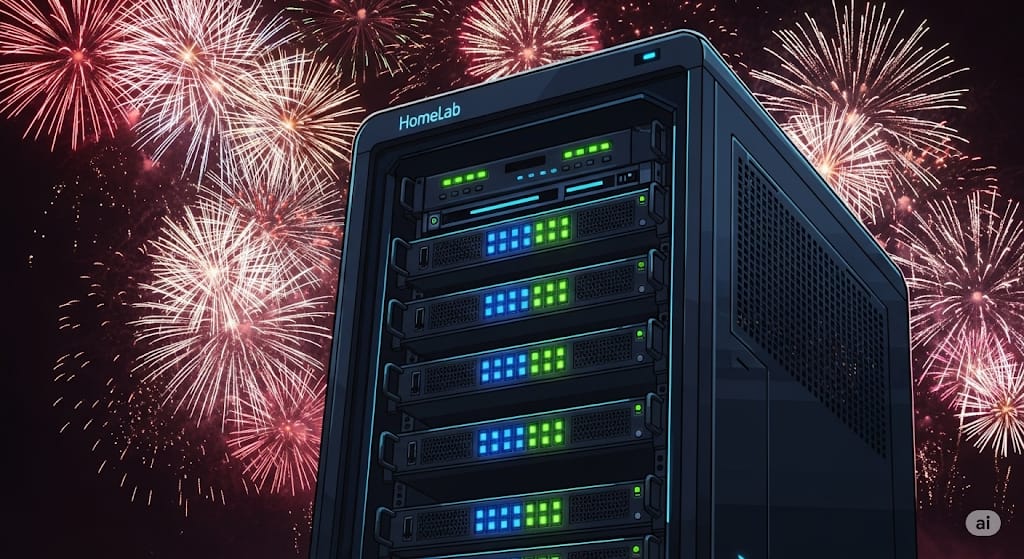⚡ News & Deals
The HL15 2.0 homelab server has launched, featuring a comprehensive hardware refresh for ZFS storage and Proxmox virtualization. This North American-made system now includes AMD EPYC CPUs, 15-bay SAS support, variable speed PWM fans, and built-in dust filters. Shipping with Rocky Linux and the Houston UI, the HL15 2.0 offers an open, upgradable, and powerful solution for homelab enthusiasts.
Intel quietly showcased new E610 NICs at HPE Discover 2025, offering low-power networking solutions. These include a dual 10Gbase-T adapter rated at just 5.1W and a quad 2.5GbE OCP NIC 3.0. The release of these efficient network cards has generated interest for their potential in various applications, though some concerns about driver maturity have been noted.
After nearly 40 years, Microsoft is replacing Windows' iconic Blue Screen of Death with a simplified Black Screen of Death in Windows 11. This summer update aims to provide clearer error information, assisting IT admins in faster issue resolution as part of broader efforts to enhance Windows system resiliency.
Cloudflare has shifted its default for new customers to block AI crawlers, reversing its previous opt-in model. Additionally, a new "Pay-Per-Crawl" beta feature allows select publishers to set prices for AI firms accessing their content. This initiative aims to empower publishers by establishing a consent-first approach, enabling them to require permission or charge fees for AI access and bolstering online content revenue.
💬 Discussions & Tutorials
Surplus enterprise SAS flash drives offer an economical solution for building all-flash Network Attached Storage (NAS) systems. These drives, despite being older, provide high endurance, significant capacity (up to 32TB raw), and low power consumption. While some may have firmware quirks or 3.3V pin issues, these can be managed, enabling enthusiasts to create powerful, high-speed home lab storage with readily available components like SAS controllers and PCIe bifurcation adapters.
The proliferation of mini NAS devices raises questions about their suitability for compact homelabs. Jeff Geerling evaluates options like the Aiffro K100, Beelink ME mini, and GMKtec G9, the focus remains on achieving an optimal balance of input/output capabilities, power efficiency, and acoustic performance to meet homelab demands.
Neeraj Adhikari distinguishes between a "homelab," used for experimentation and learning, and a "home server" setup. Adhikari's own setup, focused on running services for family with maintenance as its primary activity, highlights a lexical gap for dedicated self-hosting arrangements. This raises a question about finding an appropriate term for non-experimental home server configurations.
Tech - The Lazy Automator's guide demonstrates automating Proxmox VM deployment and configuration using Cloud-Init and Terraform. This approach streamlines the process from creation, enabling pre-configuration of usernames, passwords, static IPs, and SSH keys. The method allows for launching fully configured virtual machines directly from code, eliminating manual intervention for efficient infrastructure management.
🧰 Resources & Tools
Komodo, an open-source infrastructure management tool, offers a clean approach to DevOps workflows. Built with Rust for speed and reliability, it provides clarity by connecting servers, automating builds, and managing containers. Key features include Git-powered builds, Docker and Compose support, and flexible Web UI and CLI options, suitable for various system scales.
UniFi Drive 3.0 redefines storage management with flexible, scalable solutions. This update simplifies RAID setups, introduces adaptable RAID groups for mixed drive capacities, and enables custom workload optimization via Storage Pools. Additionally, it expands cloud integrations to major platforms and features an improved, intuitive file management experience, ensuring a powerful and streamlined data strategy.
Speakr, a new self-hosted web application, offers a robust solution for audio transcription, AI-powered summarization, and interactive chat with recorded content. Key features include simplified Docker setup, advanced speaker diarization for identifying participants, and customizable AI prompts, ensuring secure and insightful management of meeting notes directly on your server.
Postiz introduces an all-in-one, open-source social media scheduling tool. It features AI-powered content and image creation, seamless cross-posting across numerous channels, team collaboration, and comprehensive analytics. Designed for creators, businesses, and agencies, Postiz aims to streamline social media presence, enhance engagement, and optimize growth strategies efficiently.
✨ Miscellaneous
An unconventional network-attached storage (NAS) system, dubbed "FrankeNAS," was recently constructed by 2GuysTek using a MinisForum NAB9 Plus, a RAID card, and SAS drives. Assembled from various eBay parts and housed in a custom 3D-printed enclosure, this DIY TrueNAS creation demonstrates surprising functionality despite its unique build, offering a testament to innovative home server solutions.
NVIDIA PCIe GPUs are increasingly deployed across diverse server environments, moving beyond large AI factories. Featured in Supermicro systems, these GPUs—including H100/H200 NVL, RTX PRO 6000 Blackwell, and L40S/L4—cater to specific needs from high-density servers and edge computing to workstations. This widespread integration is driven by evolving latency, workflow, and data security demands, making AI acceleration accessible in various form factors.
The new Crucial T710 2TB PCIe Gen5 NVMe SSD enters the high-end market, succeeding the T705. Featuring a Silicon Motion SM2508 controller, it boasts claimed performance uplifts of up to 42% in random writes and a 24% reduction in average power use over its predecessor. With sequential speeds up to 14.5 GB/s read and 13.8 GB/s write, the T710 aims to be a top contender in the Gen5 SSD space.
Synology has launched PAS7700, an active-active NVMe all-flash storage solution for enterprise mission-critical workloads. This 4U system offers exceptional performance, achieving up to 2 million IOPS and 30GB/s sequential throughput with millisecond latency. It features robust data protection, scales to 1.65 PB, and provides primary storage-grade reliability at a cost-efficient price point for demanding applications.
